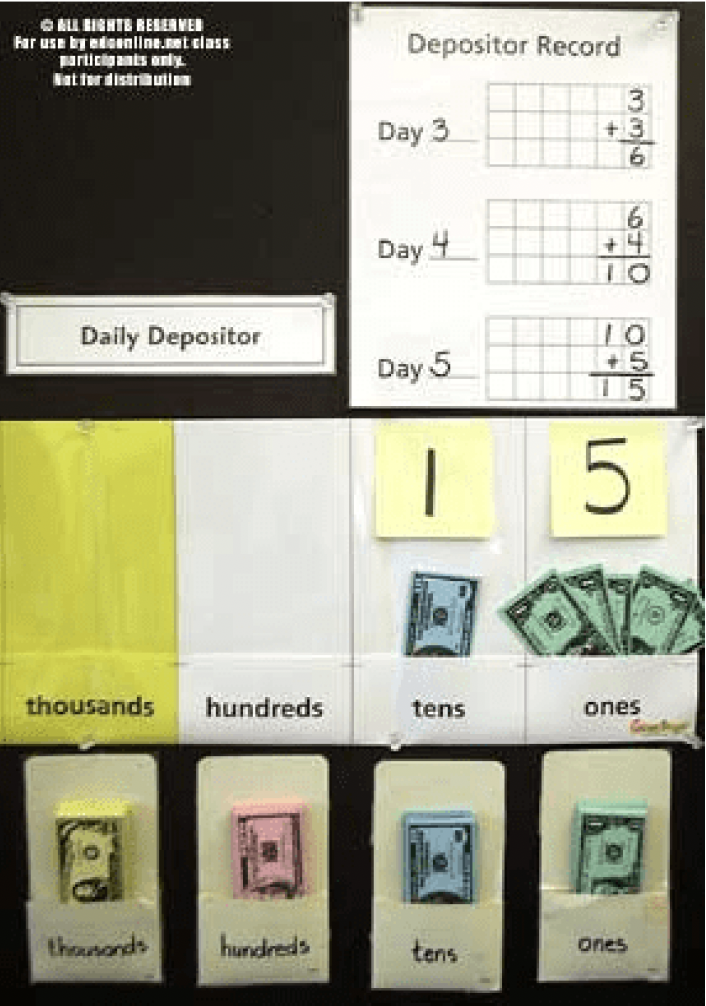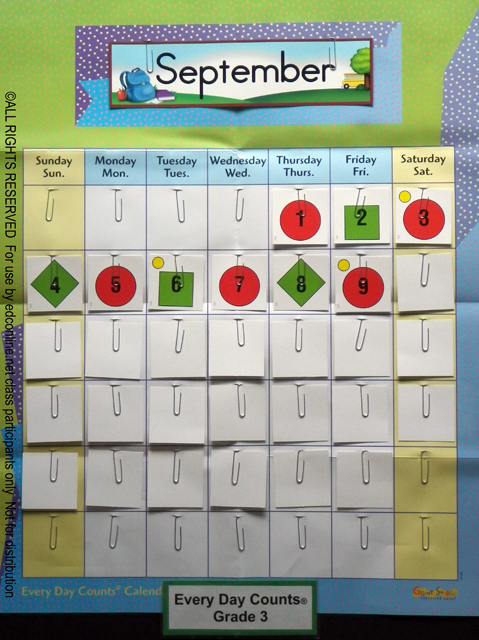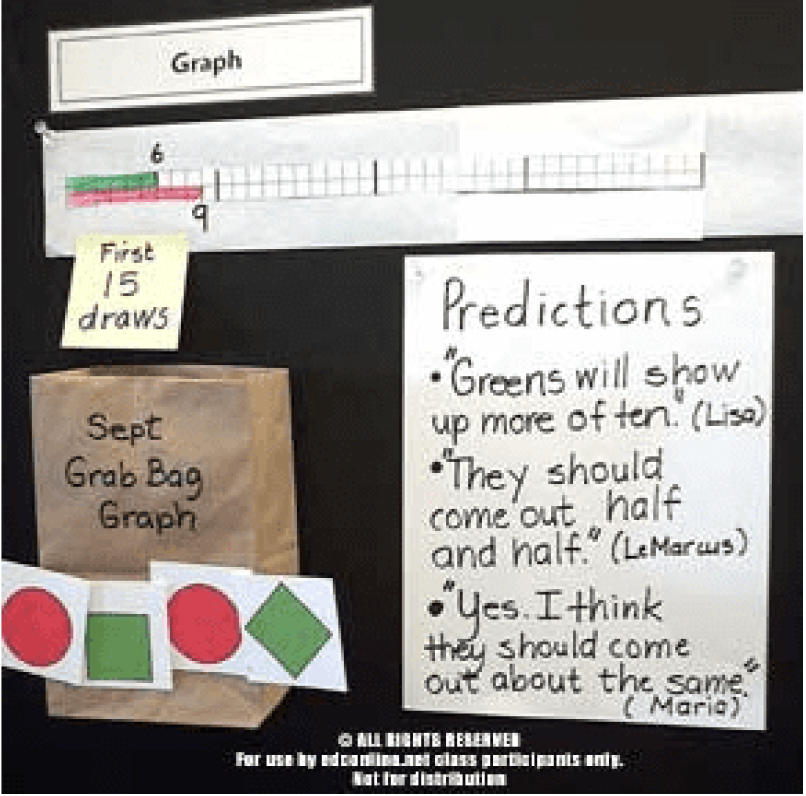Getting Started with Every Day Counts Calendar Math: Grade 3
Step 1: (30 minutes)
If you are new to Every Day Counts, read the front matter (p. 5-9) in the Every Day Counts teacher’s guide and August/September (p. 16-17). This will help you get to know the EDC elements and how to set up for the start of school.
Step 2: (5 – ? minutes)
Examine your room set-up to find the best place to display Every Day Counts so that all students can see all the elements. A bulletin board is handy for pinning up the materials, but if such a board is not present or not in a good location for viewing, many teachers have been able to place the calendar and other elements on a wall, whiteboard, or chalkboard using tape or magnets. Some have even placed a science display board or sheet of foam core in the chalk tray to tape, or pin elements to using T pins. It is nice if you can gather the children up close to view the Calendar and other elements.
EDC Counting Tape & Hundred Chart – Day of School

Step 3: (25 min. prep) Begin 1st day of school or catch up to present Day of School
See T Guide, p. 23-25 and click on Samples – Photos and Questions 3 at edconline.net
Unroll and put up at least 15 feet of the blank Adding Machine Tape or sentence strips. The Counting Tape needn’t be in the same part of the room as the other elements on the board as long as everyone can see it.
Pull the 3″ blue and yellow colored paper squares from the Every Day Counts Kit or use pads of blue and yellow post-its, or cut 3” squares from light blue and yellow 9”x12” inch construction paper (or two other light colors). You will be attaching one color of squares on each of the first ten days of school and then alternate with the other color every other ten days to 120.
Locate the blank Hundred Chart in the Every Day Counts Kit and laminate it, if possible. To prevent staining, have a black overhead pen available. Dry Erase will stain laminate. Or enlarge TR 24: Blank Hundred Chart to print on 11” x 17” paper to create a 10″ x 10″ blank grid, then mount on 12″ x 12″ construction paper.
As early in the new school year as possible, catch up the Hundred Chart to the Day of School and then continue to add one new number for each day of school thereafter. See Teacher’s Guide, p. 23.
EDC Daily Depositor – Day of School

Step 4: (15 minutes prep) Begin by the 5th day of school, if possible, or any day in the first week or so of school and catch it up to the present school day.
See T. Guide, p. 26 and click on Samples – Photos and Questions 3 at edconline.net.
Locate the Daily Depositor background from the EDC Kit or use 3 sheets each of white, yellow, and green copy paper to create the pockets. Fold each paper the long way. Then fold up bottom 2 inches and staple on each side. Tape pockets together on back side to create place value pocket chart. Make 10 copies of TR 3: 1-inch squared paper, and place one nearby to record the results of each day’s withdrawal. Have students help cut apart the supply of play money bills from the Every Day Counts Kit or from copies made using TR 6-7 from back of T Guide. Group them by denomination with rubber bands or keep them in library pockets or small ziplocks beneath the Depositor.
Have Post-its handy to record the digit above each place value pocket naming the number of bills collected of that denomination. Have Post-its handy to record the digit above each place value pocket naming the number of bills collected of that denomination.
EDC Calendar – Beginning of September or 1st Month of School


Step 5: (25 minutes prep) No lamination needed. Begin the 1st of September or catch it up to present day in September.
See T. Guide, p. 18 and click on Samples – Photos and Questions 3 at edconline.net.
Prepare Calendar by creating slits on slit marks using an Exacto knife or box cutter and placing a paper clip in each slit. Pull out the three sheets of Calendar pieces for the month and display them on the Calendar from the 1st up to the present day of the month. After the present date, place the remaining pieces face down under each paper clip (so they can be turned over one at a time on each new day of the month).
EDC Computations and Connections

Step 6: (10 min. prep) Goes with September Calendar date, so begin by the 8th of Sept. or sooner, and catch it up to the present calendar date.
See T. Guide, p.20-23, and click on Samples – Photos and Questions 3 at edconline.net.
Locate TR 2 Double Ten Grids from back of the T Guide. Make 10 copies of Double Ten Grids, cutting them apart on dotted line. Display one of the Double Ten Grid sheets. Use blue and red sticker dots, or use blue and red felt pens, to display a double (all blue dots) or double plus one (all blue double with extra red dot). With the students watching, place the dots to show the current date.
Place a copy of TR 3: Computations and Connections Record in a sheet protector to record each day’s double or neighbor fact family. (Dry erase pens usually work well with sheet protectors but will stain clear vinyl and laminate. Laminate requires use of Overhead Transparency pens). Use the extra copies of Double Ten Grid TR from back of T. ED to cut and use during the month to make a record of each “double” and “double plus one” displayed on the board. These will be used as instant recognition flash cards throughout the year.
EDC Graph – Probability Experiment

Step 7: (10 min. prep) Goes with September Calendar date, so begin by the 8th of Sept. or sooner, and catch it up to the present calendar date.
See T. Guide, p. 28-29, and click on Samples -Photos and Questions 3 at edconline.net.
Copy, cut, and tape together grid paper (TR 3 or 19) to create a graph 2 spaces wide by 40 spaces long for recording the results of this draw and replace experiment. Find the 2 red circles and 2 green squares (without numbers) from the September Calendar Pieces. A lunch sack or bag or box can be used to hold the pieces.
You are done! This is everything you will need to begin sharing the September elements with your students. September requires the greatest preparation time. Next month you will continue to use these materials and add in a couple of new items. By November all the elements will be introduced reducing preparation time for the remaining months.
To see Question Starter Cards click on SAMPLES:
The note cards you see accompanying each photo with starter questions can be printed as PDF files, cut apart, and mounted on 5×7 note cards for your easy reference during Every Day Counts discussions. During the month, please add to your cards questions of your own design or questions from your reading that you want to remember to try out. Some questions should aim at simply having students examine the data and describe what they see. Others questions should require students to engage in higher level thinking, requiring them to reason, analyze, make predictions, and form generalizations about concepts being explored each month.

